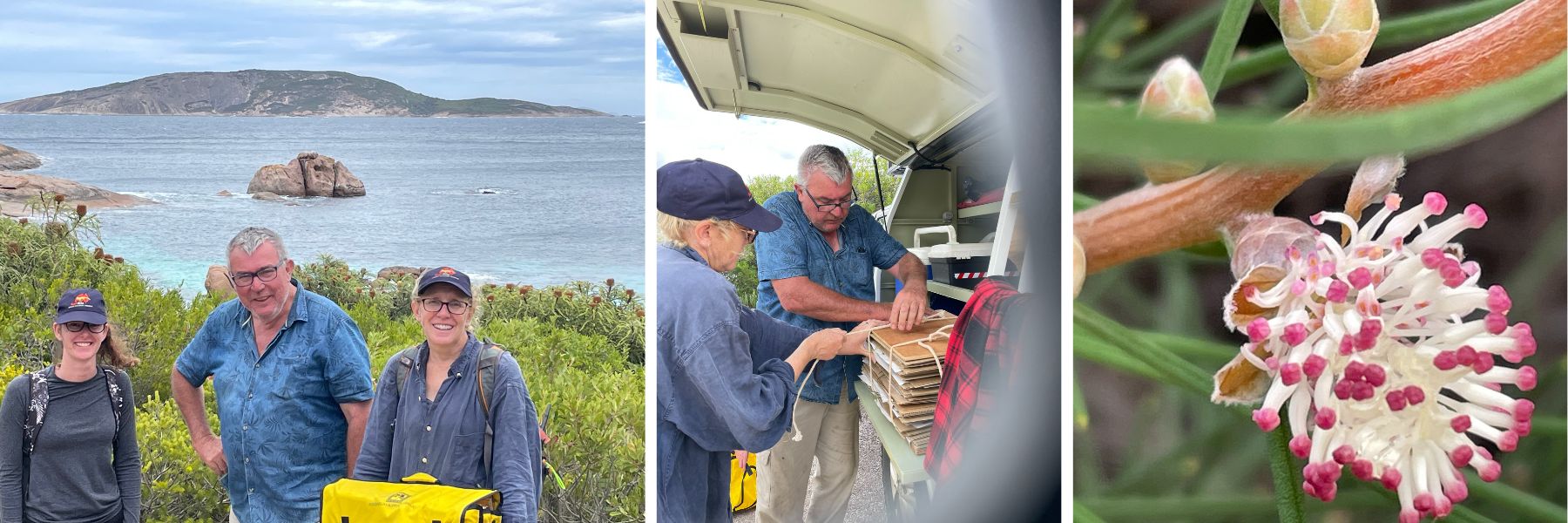Today I signed up to help the botanists, Shelley, Rob and Renee who are all from the Western Australian Herbarium (Plant Library). We departed at 8am for a quick drive around to Hellfire Bay. From there we prepared the gear and packed our backpacks for a short hike over to Little Hellfire Bay.
When we arrived, the botanists used a big tape measure to create a 20m x 20m square, called a quadrat. This was to be the focus for the rest of the day. Over the next few hours the botanists worked hard to take samples of every plant species within the square. They took cuttings from each different species, including any flowers or fruit, to help with identification. The botanists were very careful to work methodically, taking time to record the latitude and longitude, habitat, soil type and how common the species was for every plant. A few leaves were taken from every sample and placed into silica beads to help them dry out. These will be sent away for DNA testing. The remainder of the branch was then tagged and pressed, ready to be taken back to the Herbarium. Today we collected over 40 different species from the small area of the quadrat.
When fully dry, a team of volunteers at the herbarium will mount the pressed plant samples. Each plant will be identified, using dichotomous keys, and then they will be filed away on the shelves, classified by taxa, or group. The herbarium has over 900,000 specimens! They are stored in vaults at 16 degrees Celsius and 45% humidity. The cool, dry air ensures that the specimens are well preserved and protected from insects for future generations. Although we did not find any “new to science" plants today, it was still a great day out in the field watching the scientists doing what they do best. And the plants collected today will add valuable information to the Biodiversity data for the Esperance area.
Today I signed up to help the botanists, Shelley, Rob and Renee who are all from the Western Australian Herbarium (Plant Library). We departed at 8am for a quick drive around to Hellfire Bay. From there we prepared the gear and packed our backpacks for a short hike over to Little Hellfire Bay.
When we arrived, the botanists used a big tape measure to create a 20m x 20m square, called a quadrat. This was to be the focus for the rest of the day. Over the next few hours the botanists worked hard to take samples of every plant species within the square. They took cuttings from each different species, including any flowers or fruit, to help with identification. The botanists were very careful to work methodically, taking time to record the latitude and longitude, habitat, soil type and how common the species was for every plant. A few leaves were taken from every sample and placed into silica beads to help them dry out. These will be sent away for DNA testing. The remainder of the branch was then tagged and pressed, ready to be taken back to the Herbarium. Today we collected over 40 different species from the small area of the quadrat.
When fully dry, a team of volunteers at the herbarium will mount the pressed plant samples. Each plant will be identified, using dichotomous keys, and then they will be filed away on the shelves, classified by taxa, or group. The herbarium has over 900,000 specimens! They are stored in vaults at 16 degrees Celsius and 45% humidity. The cool, dry air ensures that the specimens are well preserved and protected from insects for future generations. Although we did not find any “new to science" plants today, it was still a great day out in the field watching the scientists doing what they do best. And the plants collected today will add valuable information to the Biodiversity data for the Esperance area.
